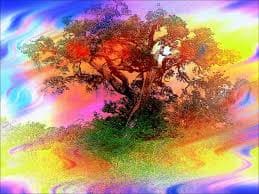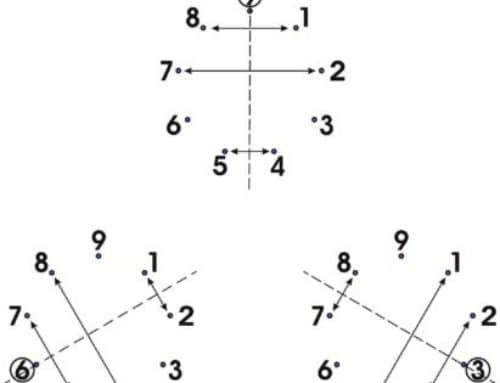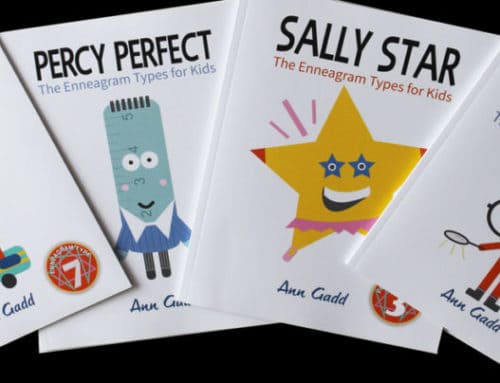Religion is the path we follow in order to reach the purpose of life.
The theme for the upcoming International Enneagram Conference in 2019 is “Foundations for the Future.” I propose that one such foundation will be built by our willingness to dialogue with one another across cultures, religions and worldviews. In our current climate of polarization and planetary peril, we must attend to the present in order to insure our future. Learning to listen to each other and mine together the riches of our collective spiritual heritage will create the conditions for a new religious consciousness to be born and bear fruit.
The Enneagram of Personality helps us know that we need one another to help us see our own blind spots and to help us become “more” of who we already are in the realm of essential Being. We have this need for the other on a religious and cultural level as well. I am using the definition of religion suggested by renowned inter-cultural philosopher, Raimon Panikkar who defines religion quite simply and broadly:
Religion is the path Man follows in order to reach the purpose of life.[1]
Such a broad definition suits our purposes as we consider bringing into dialogue a diversity of paths that human beings follow in order to reach a sense of purpose and fulfillment. These may be what we regard as traditionally religious, but also include any path a person follows towards his or her ultimate fulfillment. In our time science can satisfy this definition as well as many secular paths to personal happiness and joy.
Pluralism
Each of us looks through a window onto reality. Language is a window. Culture is a window. Religion is a window. Each view of reality is true from its own particular perspective, at least if the window is clear and transparent. But none of these views provide a complete or universal perspective. There is always more. And, as the Enneagram suggests, truth is many faceted.
Pluralism acknowledges that no one religion, culture, or system can solve by itself the monumental challenges we face in our world today. We need each other. We need to listen to each other, learn from one another and be changed in authentic encounter with truths the other holds dear. The Enneagram brings this wisdom to our inter-personal relationships. I am proposing that the Enneagram can also bring this wisdom to our inter-religious relationships.
I know, in my life and religiosity, I have sought for a common Truth with a capital “T”. The meaning of pluralism has been a growing awareness within me. The insight of no-independent-self as expressed through Buddhism seems to be at odds with the Christian belief in the immortality of the soul. The monotheism of Judaism appears to be in conflict with a Hindu’s ease with a pantheon of gods. Yet we can find common ground, and we often do, usually in the realm of practice rather than doctrine.
The articulations of each tradition are different and multi-faceted within themselves as well. The richness is in the encounter with each other. And this is also the challenge because in genuine encounter we are changed. By genuine encounter with another religious path, when we are sincerely open to the other without attempting to convert or convince, we are changed. I am changed. And this is the precariousness of authentic dialogue: our willingness to be changed in the encounter, to be made new. In our time, when humanity faces monumental challenges as have never before existed, we need all of the richness of our cultural and spiritual traditions. In their meeting a mutual fecundation can occur that can create new possibilities, heal divisions and shine a light on a way forward together.
The narrative tradition of the Enneagram particularly lends itself to intra-religious dialogue. Intrareligious dialogue is about a deep engagement within one’s own faith, tradition and within one’s own self, as one’s spiritual path becomes enriched (as well as challenged) through an encounter with the other. It is about respect and deep listening. It is dialogical rather than dialectical. Whereas dialectical dialogue is conceptual and object oriented, dialogical dialogue is based on one’s faith experience. It is cross-cultural and transformational. It is personal and subject oriented. Imagine using the Enneagram narrative tradition as a forum for bringing panels of like religious traditions into deeper listening to, and understanding of, traditions different from their own.
I find so much resonance with the aims of Intrareligious Dialogue and the Enneagram. Through the work of Helen Palmer and David Daniels, I have come to a deep appreciation of the narrative tradition that employs panels of diverse Enneagram types. Deeply listening to how others perceive the world results in building bridges and overcoming misunderstandings. The panels allow people to speak out of their own insights and direct experience while being witnessed and heard.
The Trinitarian Nature of Reality
I have already mentioned Raimon Panikkar. An interesting place of intersection between Panikkar’s thought and the Enneagram is in the understanding of the triadic nature of reality. Panikkar suggests that there is an emerging religious consciousness that is neither monistic, nor dualistic but trinitarian (or advaitic)[2]. In his book The Rhythm of Being, he sketches how the human mind has discovered this trinitarian pattern throughout cultures and religious traditions. As he says:
“Our mind discovers the trinitarian pattern because the very constitution of reality is triadic.”[3]
Panikkar has thoroughly influenced my way of thinking. Many of our traditions have become so mired in orthodoxy, and mental constructs that they sever themselves from direct experience of the fullness of life. This direct experience of essence, in Enneagram language, involves all three centers of intelligence. As Panikkar says,
“To assume that faith can define God amounts to idolatry. Likewise, to assume that reason can define what the world is amounts to rationalism; and to assume that what our senses tell us is reality amounts to materialism. The three eyes together allow us to penetrate into the mystery of the real without exhausting reality.”[4]
Our leap beyond the limits of our rational mind does not diminish the intellect. It is our intelligence that recognizes that knowledge is more than reason. Knowledge includes love. And love is always in relationship.
I believe this is the genius of a radical trinitarian vision of reality. The Divine, Cosmic and the Human are constitutive relationships. They are dimensions of the Whole. They cannot be collapsed into a unity, nor be separated into a polarity. The relationship is advaitic, non-dual.
For example, I love the beauty of a maple tree in her fall radiance, and the transparency of her yellow leaves glowing in the slanting sunlight. (cosmos). What arises in me as love is invisible to my eye. It is the “more” which the beauty of the tree invites me into, the depth dimension shining through the golden maple; (divine). And then there is ”I:” a connecting, loving, witnessing consciousness. (human). The reality is a loving relation, a trinity of love, between God, World and Man, what Panikkar has called Cosmotheandric.[5]The three are interconnected and cannot be separated. Here one can recall the Buddhist intuition of the pratiyasamutpadah (interdependent co-arising) or the Christian understanding of trinity.
An Enneagram of Religious Personality
In this spirit of loving inter-connected relationship I offer the following reflection about how the Enneagram and the narrative tradition might contribute to intrareligious dialogue.
I teach the Enneagram as part of a prison program called the Lioness Tale Prison Project, based on a book I wrote called The Lioness Tale.[6] In the LiT-uPP program we teach the Enneagram[7] as a framework for understanding ourselves and others
We introduce the essential states described by the Enneagram as integral to the divine dimension of the cosmotheandric reality in which we participate.
I introduce these essential states of the Enneagram by inviting participants to imagine a beautifully cut diamond held up to a light source. As the light hits the diamond, the light is refracted into color… not just one color, but many colors. Even though the light hitting the diamond is one beam of light, when it strikes the form of the diamond we experience the light as blue, green, violet— a whole spectrum of color. In the same way, when the divine light shines through our lives without obstruction—in other words, when we are transparent to this light— not only do we experience the refraction of the light, first at the entry point of love and then through all the essential qualities of the Enneagram,, but others experience these qualities as well. These essential states are what we experience when we are in the presence of someone we feel is a sage or an awakened person. These states radiate presence. From the Enneagram perspective, when we are born we are like this clear diamond, we radiate essence. And if you’ve been around a new-born you probably know what I mean. But with form, with a human body also comes pain and estrangement from this pure experience of being.
The Enneagram describes nine primary ways that human beings experience this estrangement. Seven of these so-called fixations are the seven deadly sins named by the Christian tradition: sloth, anger, pride, envy, avarice, gluttony and lust. There are two more named by the Enneagram: fear and deceit. The Enneagram describes how personality develops as a result of particular wounds to essence and how attention correspondingly “fixates” on one of the corresponding “sins” as a means of defense, skewing one’s perception of reality. For example a “Point 6” on the Enneagram is wounded in the essential quality of Faith. They have lost trust in the fundamental goodness of reality. Their experience of the world is that it is a dangerous and frightening place. Thus a habit of attention is developed which scans the environment for threat and perceives reality as inherently threatening and untrustworthy. They are fixated in fear and doubt due to a wound to the essential quality of faith, thus distorting their view of reality and separating them from the essential quality (in this example, “faith”) that could “redeem” them, so to speak.
The Enneagram contribution to Intra-religious Dialogue
With this very cursory introduction to the Enneagram I want to apply some of its insights to our topic of an Enneagram of Religious personality
We’ve just explored the example of how one personality type, wounded in the essential quality of Faith, has at its root a blind spot which narrows focus on Reality in a habitual pattern that distorts apprehension of Reality in its fullness. Is it possible, that like the different personalities described by the Enneagram, that religious traditions might have both their own blind spots as well as their own unique manifestation of the diamond light? Seeking for ways to expose our blind spots, panels of like-types talk about how they see the world. In doing so, not only do they bring unconscious habits to conscious awareness for themselves, but they allow others of different type to awaken to the fact that other personalities see the world quite differently than they do. This deep personal sharing about how we perceive our reality helps everyone involved move from habitual behavior to conscious choice and a deeper appreciation of the talents and gifts that each type brings.
Similarly, in dialogical dialogue with other religious traditions the obscurations of our own tradition begin to reveal themselves and a fuller apprehension of Reality is made more accessible. Through dialogical dialogue we begin to appreciate each facet of the diamond which is illuminated through the unique perceptions and cultural experiences of each religious tradition. The Enneagram teaches that by bringing the light of awareness to our unique personality structure, the energies of transformation, heretofore bound up in the unconscious patterns of personality, move naturally toward the essential quality at the type’s core. This gives access to the ennea-type’s unique gift and insight into the nature of Reality.
Similarly, each religious tradition brings its own unique access to reality. As the light of undivided reality hits the prism of Christianity (for instance), a unique access to personhood and incarnation is made accessible to us. Let’s say it manifests as the color “rose”. But “rose” is not “gold” which may be the particular and unique light that the diamond facet of Buddhism manifests. Just as each personality has locked up in its shadow (or wound, or blind spot), a unique talent, intuition or access to a depth of insight into one of the essential facets of the diamond light, so too does each religious tradition when released from its narrowness and doctrinal blind spots. How religions are released from this narrowness is in dialogue with each other and through the personal willingness of individuals to engage in intra-religious dialogue, that is an inner conversation within themselves, with their own tradition and in encounter with another.
Just as a point 6 on the Enneagram does not cease to have the personality structure shaped by his/her way of perceiving the world as he/she moves from shadow to light, so we don’t give up our tradition into some eclectic melting pot so that we lose the brilliance of its particular light. Rather the illumination or gift of our own tradition is purified and deepened in our encounter with the other. This encounter does not ask for agreement or some kind of victory but for a common recognition of truth without blotting out the full spectrum of beauty and diversity revealed through the entire rainbow.
The Lioness Tale Prison Project: LiT-uPP
The Lioness Tale Prison Project, or LiT-uPP for short, is a project deeply grounded in principles of intra-religious dialogue, and pluralism. We have successfully piloted this transformational project at the Central California Women’s Facility, one of the largest women’s prisons in the world, with the intention of growing it both nationally and internationally. To borrow from a title from one of Raimon Panikkar’s books, we are about creating “a dwelling place for wisdom”[8] within an institutional structure largely shaped by ignorance, fear, violence and the cultural armaments of power and control. Yet the people physically incarcerated within the prison system are not necessarily spiritually bound by it. They have within themselves the capacity, not only to transcend their physical circumstances, but to be the very agents of transformation by tapping the human, cosmic and divine energies at the center of their own being.
We teach an array of skills for becoming receptive to the cosmotheandric energy at the core of our own true nature and becoming embodiments of the essential freedom it engenders. The Enneagram is integrated into this transformational process[9].
In the LiT-uPP program, we are all involved– myself included– in an intra-personal dialogue with different dimensions of ourselves and our own life stories, expanding our view and cleansing the window of our perceptions facilitating thereby an openness to an awareness of reality for which we can be spokespersons.
We are also involved in an intrareligious dialogue, examining our own beliefs, freeing ourselves from narrowness and opening our hearts in compassion to the light emanating from windows other than our own. We appreciate the multi-faceted diamond of the cosmotheandric reality we share. We disarm ourselves. We soften our defenses. We recognize ourselves as part of one another. We become a community. We create a dwelling place for wisdom, even in prison, even in the belly of the beast. If we can awaken here, we can awaken everywhere. We are building foundations for a love filled future.
[1] The Intrareligious Dialogue, Raimon Panikkar, Paulist Press, 1978, p78
[2] The Rhythm of Being, Raimon Panikkar, Orbis, 2010, “Advaita amounts to the overcoming of dualistic dialectics by means of introducing love at the ultimate level of reality”. P. 216
[3]The Rhythm of Being, p. 213
[4] Ibid. P. 241
[5] And in other places he uses Theanthroposcosmic. In English the word “Man” is problematic because it has too often been used to mean men at the exclusion of women. Raimon’s use of Man, with a capital M attempts a correction. He means Man to be the fullness of the whole Person, more than a member of a species: “human”. Thus he doesn’t like using “human” as a substitute. I have chosen to use his preferred terminology, while recognizing the limitations.
[6] The Lioness Tale, Diane Pendola
[7] The Essential Enneagram, David Daniels, Harper/Collins, 2009
[8] Raimon Panikkar, A Dwelling Place For Wisdom, (Westminster/John Knox Press) 1993
[9] www.thelionesstale.org for more information on LiT-uPP





